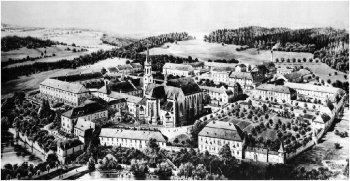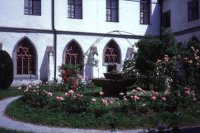The term: feudal foundation and/or monastery's domain
 A feudal foundation - domain was more than just a monastery. It includes not only the spiritual but also a secular sphere. A precondition of such a foundation was the donation of a domain with land. The abbot, who was a member of the prelate estate in the local parliament, was not only in charge of discipline in his monastery, but he also held public, i.e. state rights: administrative rights, police power and jurisdiction over the serfs settled in the area of the domain’s land. These serfs were given the land on hire, for which they had to pay rent to the owner. The relationship of these “land holders” to the landlord was expressed in the ownership rights that they were granted. While the free domain right was the least advantageous ownership right, as its holder could be dismissed from his farmstead annually, the purchase right was a better one,
A feudal foundation - domain was more than just a monastery. It includes not only the spiritual but also a secular sphere. A precondition of such a foundation was the donation of a domain with land. The abbot, who was a member of the prelate estate in the local parliament, was not only in charge of discipline in his monastery, but he also held public, i.e. state rights: administrative rights, police power and jurisdiction over the serfs settled in the area of the domain’s land. These serfs were given the land on hire, for which they had to pay rent to the owner. The relationship of these “land holders” to the landlord was expressed in the ownership rights that they were granted. While the free domain right was the least advantageous ownership right, as its holder could be dismissed from his farmstead annually, the purchase right was a better one,  comparable to renting a flat under rent control. This right was in general instituted in ecclesiastic domains, which gave rise to the common saying: “Life is good under the crozier.” The area of a monastery domain was, for the purposes of better recording, divided into administrative sections, each called departments, in which the administrative function was executed by a secular clerk supervised by the monastery. Thus for example in the 18th century the area of the monastery domain Vyšší Brod involved 31 departments.
comparable to renting a flat under rent control. This right was in general instituted in ecclesiastic domains, which gave rise to the common saying: “Life is good under the crozier.” The area of a monastery domain was, for the purposes of better recording, divided into administrative sections, each called departments, in which the administrative function was executed by a secular clerk supervised by the monastery. Thus for example in the 18th century the area of the monastery domain Vyšší Brod involved 31 departments.
